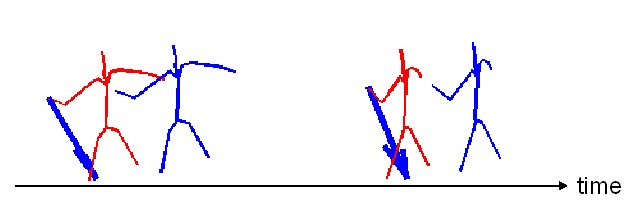・身体動作修正のための人体計測・可視化
Our goal is to develop a system for coaching human motions (e.g. rehabilitation). Common motion measurement systems are too expensive and require users to wear binding devices. The proposed system utilizes an inexpensive depth-measurement sensor (i.e. Microsoft Kinect). in order to get high-measurement accuracy with no body-equipped devices. The system functionally consists of three modules below. The first one estimates the sequence of a body pose from a depth image sequence captured while a user performs a target motion. The second one evaluates the gaps between the sequences of the estimated poses and a good template. The third one coaches the user on how to modify his/her motion so that it gets closer to the good template. This work focuses on achieving the third point. To this end, it is important to efficiently advise the user to emulate the crucial features that define the good template. This is because many other features of the target motion might be varied among individuals, but those variations give less impacts on evaluating the target motion. The proposed method automatically mines the crucial features of any kind of motions from a set of all motion features. The crucial features are mined based on feature sparsification through binary classification between the samples of good and other motions. Experimental results demonstrated that 1) the proposed method could extract intuitively-correct crucial features (as shown in Fig. 1) and 2) the extracted features improved the accuracy in classifying good and other motions.
The development of a widely applicable automatic motion coaching
system requires to address a lot of issues including motion capturing,
motion analysis and comparison, error detection as well as error
feedback. In order to cope with this complexity, most existing
approaches focus on a specific motion sequence or exercise. As a first
step for the development of a more generic system, this work
systematically analyzes different error and feedback types. A
prototype of a feedback system that addresses multiple modalities is
presented. The system allows to evaluate the applicability of the
proposed feedback techniques for arbitrary types of motions in a next
step. The screenshot of the developed interface system is shown in
Figure 2.
This work discusses the usefulness of human body-parts tracking for
acquiring subtle cues in social interactions. While many kinds of
body-parts tracking algorithms have been proposed, we focus on
particle filtering-based tracking using prior models, which have
several advantages for researches on social interactions. As a first
step for extracting subtle cues from videos of social interaction
behaviors, the advantages, disadvantages, and prospective properties
of the body-parts tracking using prior models are summarized with
actual results.


